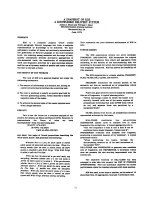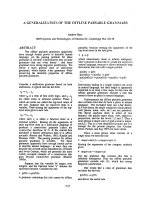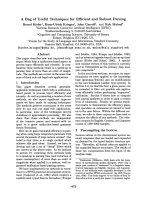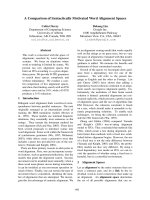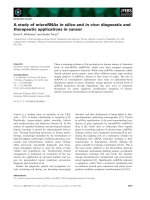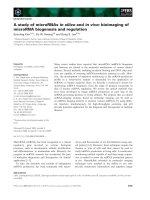báo cáo khoa học: "A nano-view of West Nile virus-induced cellular changes during infection" pps
Bạn đang xem bản rút gọn của tài liệu. Xem và tải ngay bản đầy đủ của tài liệu tại đây (390.04 KB, 7 trang )
BioMed Central
Page 1 of 7
(page number not for citation purposes)
Journal of Nanobiotechnology
Open Access
Research
A nano-view of West Nile virus-induced cellular changes during
infection
Jason WM Lee and Mah-Lee Ng*
Address: Department of Microbiology, 5 Science Drive 2, National University of Singapore, Singapore 117597, Singapore
Email: Jason WM Lee - ; Mah-Lee Ng* -
* Corresponding author
Abstract
Background: Microscopic imaging of viruses and their interactions with and effects on host cells
are frequently held back by limitations of the microscope's resolution or the invasive nature of the
sample preparation procedures. It is also difficult to have a technique that would allow simultaneous
imaging of both surface and sub-surface on the same cell. This has hampered endeavours to
elucidate virus-host interactions. Atomic Force Microscopy (AFM), which is commonly used in the
physical sciences, is now becoming a good correlative form of microscopy used to complement
existing optical, confocal and electron microscopy for biological applications
Results: In this study, the West Nile (Sarafend) virus-infected Vero cell model was used. The
atomic force microscope was found to be useful in producing high resolution images of virus-host
events with minimal sample processing requirements. The AFM was able to image the budding of
the West Nile (Sarafend) virus at the infected cell surface. Proliferation of the filopodia and
thickening of clusters of actin filaments accompanied West Nile virus replication.
Conclusions: The study shows that the AFM is useful for virus-host interaction studies. The
technique provides morphological information on both the virus and the host cell during the
infection stages.
Background
Viral infections represent a particularly difficult type of
challenge to overcome. Though the field of anti-viral strat-
egies continues to grow, success rates lag greatly behind
antibacterial strategies. This is due in large part to the lack
of understanding of virus interactions with their host
cells. The small scale of viruses results in difficulties in the
efficient imaging of virus-infected samples.
To date, the microscopy forms that are able to achieve the
level of magnification and resolution for imaging viruses
are the scanning electron microscope (SEM) and transmis-
sion electron microscope (TEM). Both these techniques
have a requirement for tedious levels of sample process-
ing. The invention of the atomic force microscope (AFM)
by Binnig and colleagues [1] has allowed for high-resolu-
tion imaging of nanostructures in living samples [2-4]. A
number of these studies involved the observation of puri-
fied samples of biomolecules including large viruses, for
example, the tobacco mosaic virus, pox virus and human
immunodeficiency virus [5-7]. The homogeneity in the
sample appears to lend itself to better AFM imaging.
The AFM is able to produce images in several different for-
mats, of which three were consistently analysed: height,
phase and amplitude. The height data image is obtained
via recording the changes in AFM scanner height as it
shifts to keep the vibrational amplitude of the cantilever
Published: 29 June 2004
Journal of Nanobiotechnology 2004, 2:6 doi:10.1186/1477-3155-2-6
Received: 05 April 2004
Accepted: 29 June 2004
This article is available from: />© 2004 Lee and Ng; licensee BioMed Central Ltd. This is an Open Access article: verbatim copying and redistribution of this article are permitted in all
media for any purpose, provided this notice is preserved along with the article's original URL.
Journal of Nanobiotechnology 2004, 2:6 />Page 2 of 7
(page number not for citation purposes)
of the probe constant. This produces an image with highly
accurate quantitative height measurements. The phase
data image produces an image that provides information
of the differing materials/texture in the sample by analyz-
ing the different responses of the probe on such materials.
The amplitude data image produces an emphasized view
of the height data image by describing the change in the
amplitude of the probe directly. While structures are not
distorted in the amplitude data image, accurate quantita-
tive measurements are more likely garnered from the
height data image.
The AFM does not require much in sample processing: in
fact, its main requirement is that the sample is well-
adhered to a substrate such that it does not move around
when the AFM probe engages it. Beyond that, additional
sample preparation such as fixation or labelling is decided
on a sample-specific basis. While a live sample would be
an ideal specimen to study, biosafety concerns stipulated
the use of mild fixation in our virus infected samples. Fix-
ation was preformed on mock-infected samples for the
sake of consistency. As a result, the observations in the
study are based on the interpretation of static pictures.
The objectives of this study are to investigate the suitabil-
ity of atomic force microscopy for virus-host interaction
studies using the flavivirus model. In addition, to gauge if
the images obtained can reveal more information than
with the known conventional ultra-structural studies.
Results and Discussion
West Nile (Sarafend) virus-induced changes in infected
cells at late stage infection
At the late stages of West Nile (Sarafend) virus infection in
Vero cells, several interesting aspects warranted investiga-
tion. One unique aspect was the maturation of this virus
at the plasma membrane. This observation was first
reported by Ng and colleagues [8,9]. Active budding was
also present at the proliferated filopodia. In conjunction
with the budding of the maturing virus particles, there was
a progressive lengthening and thickening of the actin fila-
ments at the cell peripheral. The postulation was that the
vectorial force of the growing length of the actin filament
provided the bending force to expel the virus particles
[10].
Figs. 1a &1b show a budding virus (arrowhead) extruding
from the plasma membrane at 24 h p.i. Fig. 1b shows a
higher resolution scan of the extruding virion, with the
envelope clearly surrounding the virus nucleocapsid
(arrowhead). A TEM image of a virus particle (Fig. 1c) was
included for comparison. The arrowheads point to the
extruding progeny virions while the arrow indicates the
electron dense immunogold label targeted against the
WNV envelope protein. The AFM image gave a 3-dimen-
sional view of the entire budding virus.
The hard tapping AFM technique used provided a certain
degree of "translucency" to the plasma membrane, which
enabled the imaging of sub-surface structures in addition
to producing surface morphological data. By adjusting the
probe to engage the sample with greater force, the probe
tip physically pushes against the soft sample surface to
image sub-surface structures. It was through this ability
that the AFM was able to observe the up-regulation of
actin filaments in the late infection stages.
In Fig. 2 the formation of actin filaments near the cell
periphery in infected cells was seen over time. Fig. 2a
shows some degree of enhancement of the cytoskeleton
network around the cell periphery (arrow) in the West
Nile (Sarafend) virus-infected Vero cells at 12 h p.i. Fig. 2b
shows an increased degree of cytoskeletal thickening
(arrow) of similarly infected cells at 16 h p.i. It is noted
that the formation of cytoskeleton clustering in the
infected cells appears to be proximal to the formation of
filopodia. The three-dimensional reconstruction of Fig. 2b
illustrates the induced skeletal filaments (Fig. 2c, arrows)
encroaching into newly formed filopodia (arrowheads).
This detailed progression of cytoskeleton enhancement
cannot be visualized by the SEM (as it can only provide
surface morphology data) or TEM (as it can only provide
2-dimensional data). A lower magnification scan of a
mock-infected Vero control cell is provided in Fig. 2d.
While the endoplasmic reticulum region is clearly
observed at the perinuclear region (arrow), there is the
lack of the filopodia and cytoskeleton clustering that is
observed in the West Nile virus-infected cells at the
periphery of the plasma membrane.
At late infection, filopodia were readily seen to be radiat-
ing from the infected cell periphery. These structures were
not seen in mock-infected Vero cells at 36 h p.i. (Fig. 3a).
These control cells also showed a lack of cytoskeletal for-
mation at the periphery of the plasma membrane when
compared to infected cells. Fig. 3b shows the filopodia
(arrows) formation between four infected host cells at 36
h p.i. Fig. 3c shows bags of virus particles (thin arrows)
liberated from the cells surface as well as the filopodia at
36 h p.i. During this stage of infection when the cyto-
pathic effects were advanced, progeny viruses no longer
budded out individually but in bags [9]. The thick arrow
shows regions of cytoskeleton thickening in the infected
cells. Arrowhead points to the virus-induced filopodia for-
mation. The TEM micrograph in Fig. 3d confirmed similar
bags of virus particles (arrows) at the extracellular space.
Arrowhead shows the filopodia, but these were not as
pronounced as in the AFM imaging due to required
ultrathin sectioning of the sample.
Journal of Nanobiotechnology 2004, 2:6 />Page 3 of 7
(page number not for citation purposes)
(a) AFM height scan of West Nile virus-infected Vero cells at 24 h p.iFigure 1
(a) AFM height scan of West Nile virus-infected Vero cells at 24 h p.i. Scan size is 251 nm × 251 nm. A progeny virus (arrow)
budding from the plasma membrane of the host cell. (b) AFM height scan of West Nile virus-infected Vero cells at 24 h p.i. Scan
size is 98.4 nm × 98.4 nm. Arrowhead shows the envelope surrounding the budding progeny virus. (c) TEM image of West Nile
virus-infected Vero cells (arrowheads) budding from host cell. The electron dense dots are the immunogold particles targeted
against the envelope protein of the WNV.
Journal of Nanobiotechnology 2004, 2:6 />Page 4 of 7
(page number not for citation purposes)
(a) AFM height scan of West Nile virus – infected Vero cells at 12 h p.iFigure 2
(a) AFM height scan of West Nile virus – infected Vero cells at 12 h p.i. Scan size is 19.6 µm × 19.6 µm. Arrow shows some
degree of enhanced cytoskeleton formation. (b) AFM height scan of West Nile virus – infected Vero cells at 24 h p.i. Scan size
is 15.3 µm × 15.3 µm. Arrows show greater degree of thickening and clumping of actin filaments in close proximity to the cell
periphery of the infected cell at 16 h p.i. (c) AFM 3D height scan of 15.3 µm × 15.3 µm size. Arrows show the actin filaments
forming near the cell edge and the nascent filopodia (arrowheads). (d) AFM height scan of mock-infected Vero cells at 24 h p.i.
Scan size is 30 µm × 30 µm. This control cell shows a lack of cytoskeleton thickening and clumping at the periphery of the cell
plasma membrane. The rough endoplasmic reticulum is indicated by the arrow.
Journal of Nanobiotechnology 2004, 2:6 />Page 5 of 7
(page number not for citation purposes)
(a) AFM height scan of mock – infected Vero cells at 36 h p.iFigure 3
(a) AFM height scan of mock – infected Vero cells at 36 h p.i. Scan size is 10 µm × 10 µm. In the mock-infected control sample,
a distinct lack of filopodia and cytoskeleton formation is obvious. The bright spots depict high regions of the cells. (b) AFM
amplitude scan of West Nile virus – infected Vero cells at 36 h p.i. Scan size is 50 µm × 50 µm. Arrows show the filopodia pro-
duced by these four infected cells. (c) AFM height scan of West Nile virus – infected Vero cells at 36 h p.i. of 6.9 µm × 6.9 µm
size. Thin arrows show enveloped bags containing progeny West Nile viruses as they egress from host Vero cells. The arrow-
head shows the filopodia formed in infected cells. Thick arrow shows the actin filaments near the budding enveloped bags. (d)
The transmission electron micrograph shows similar image as in (c). The bags of virus (arrows) are seen exiting from the cell
filopodia (filopodia).
Journal of Nanobiotechnology 2004, 2:6 />Page 6 of 7
(page number not for citation purposes)
Conclusions
The AFM successfully imaged the West Nile virus-induced
changes in infected Vero cells. Both the TappingMode™
and hard tapping mode were used in this study. As this is
the first study using atomic force microscopy for flavivi-
ruses, a more cautious approach was taken. Mildly-fixed
infected cells were used to optimize the AFM technique
for virus-host interaction studies. To gain further confi-
dence with this technique, transmission electron micro-
graphs were included for comparison. As these samples
were fixed and dried prior to imaging, certain considera-
tions had to be addressed.
The effects of this drying procedure may cause a certain
degree of flattening to the nanostructures on the sample,
and this was taken into account during interpretation of
the results. Drying may also increase the surface rough-
ness [11] of the sample. However, the effect of fixation on
these samples brings the samples morphologically more
similar to the TEM images that we used for comparison,
and made such comparisons more meaningful. At such an
early stage of research, confirmations and corroboration
from other more established microscopy forms are essen-
tial to successfully interpret the results from the AFM.
Since the cells are soft textured samples, TappingMode™
was the preferred mode used. The alternative contact
mode involves the constant contact between the probe
and the sample, thus causing damage to the soft biological
samples. Hard tapping was applied when there was a need
to image sub-surface structures. These modes proved to be
very compatible for virus and cell imaging.
In the case of West Nile (Sarafend) virus infections, the
new information provided by the AFM gave further
insight into virus-induced changes during the infection.
Nanostructures such as the budding of individual progeny
viruses (Fig.1) or of bags containing progeny virus were
observed as enveloped sacs associated with the filopodia
extending from the plasma membrane in the West Nile
virus-infected Vero cells (Fig. 2). The AFM can image the
virus-induced changes in the host cell as well as minute
structures (50 nm) such as West Nile virus particles illus-
trates that the AFM is able to provide both the macro and
nano data germane to virus-host interaction studies. The
usefulness of hard tapping techniques was most notable
in the observation of actin filament formation near the
periphery of the infected cell membrane. The time course
of West Nile virus infection through the Vero cell has been
documented in previous studies [8-10] using other micro-
scopy forms, and they corroborate the observations made
in this study using the AFM.
The virus studied here is of great medical and economical
impact on the world. Flaviviruses have long been a medi-
cal problem in many parts of the world [12], especially
with the resurgence of West Nile virus infections in North
America [13]. With emerging and re-emerging viruses
such as this, new and pertinent data of how these viruses
replicate in their host cells is becoming increasingly and
urgently needed. The nano-biotechnological field of AFM
represents a new set of "eyes" in which virologists may use
to meet these new challenges.
Methods
Cells
Vero cells derived from African green monkey kidney (a
kind gift from Professor E. G. Westaway, Sir Albert Sakze-
wski Virus Research Laboratory, Queensland, Australia)
were used. Cell lines were maintained in M199 growth
media supplemented with 10% foetal calf serum (FCS).
Cells were cultured onto sterile ethanol-treated coverslips
placed into 24-well cell culture plates and incubated over-
night to achieve a level of 80% confluency. These cells
were used for virus infection studies.
Virus
West Nile (Sarafend) virus, a kind gift from Professor E. G.
Westaway, Sir Albert Sakzewski Virus Research Labora-
tory, Queensland, Australia), was propagated in Vero cells
throughout this study.
Flavivirus infection of cells
The Vero cells were infected with West Nile (Sarafend)
virus at a multiplicity of infection (M.O.I.) = 1. The cells
grown on the coverslips were washed once with PBS,
before infection with 100 µl of viruses for 1 h. The cover-
slips were rocked gently every 15 min to ensure the uni-
form spreading of the virus solution over the cell
monolayer on the coverslip. After 1 h of infection, 1.5 ml
of the appropriate growth media supplemented with 2%
FCS was added to the coverslips, and these were left to
incubate in a 5% CO
2
incubator at 37°C. The samples
were fixed, and imaged at 12, 16, 24 and 36 h p.i.
Sample preparation
As this is a pioneering study on the flavivirus, mildly fixed
samples were used. The samples were washed thrice with
PBS for the duration of 5 min each time, after which they
were fixed with a 2% paraformaldehyde/0.2% glutaralde-
hyde solution at pH 7.4 for 30 min. The fixative solution
was decanted and the samples washed twice with PBS. A
final wash with deionised water was followed by gentle
drying with a nitrogen gas gun.
AFM
The samples were then imaged in the AFM using the Force
Modulation Etched Silicon Probe (FESP), (Veeco, USA)
which has a length of 219 µm and a vibrational frequency
of 69-88 kHz.
Publish with Bio Med Central and every
scientist can read your work free of charge
"BioMed Central will be the most significant development for
disseminating the results of biomedical research in our lifetime."
Sir Paul Nurse, Cancer Research UK
Your research papers will be:
available free of charge to the entire biomedical community
peer reviewed and published immediately upon acceptance
cited in PubMed and archived on PubMed Central
yours — you keep the copyright
Submit your manuscript here:
/>BioMedcentral
Journal of Nanobiotechnology 2004, 2:6 />Page 7 of 7
(page number not for citation purposes)
Cryo-Immunolabelling Electron Microscopy
At selected times p.i., Vero cells infected with WNV were
washed twice with cold PBS and fixed with 0.2%
glutaraldehyde/ 4 % paraformaldehyde for 30 min. The
cells were scraped and spun down. The cell pellet was
resuspended in 10% gelatin at room temperature and
spin, and the gelatin with the pelleted cells was solidified
at 4°C for 10 min. The hardened block was post-fixed
with the above fixative again for 20 min. The gelatin block
was then cut into 1-mm cubes and immersed into cryo-
protection buffer of 2.3 M sucrose for 2 h. The block was
frozen by plunging into liquid nitrogen before cryo-ultra-
microtomy, using an ultracut microtome (UCT) with a
cryo-attachment (EM FCS – Leica, Austria). Ultrathin sec-
tions of the infected cells were picked up onto Formvar-
coated grids and immunolabelling was carried out at
room temperature. The sections were washed for 10 min
with PBS. This was followed by three washes (at 5 min
each) with 0.05 M glycine in PBS (to block the aldehyde
groups) before incubating for 30 min in PBS with 5% BSA
(protein block). Sections were then washed in 0.1% BSA
in PBS (3 × 5 min) and exposed to the primary antibody
(against the WNV envelope protein) at 1:100 dilution
(0.1% BSA in PBS) for 1 h. Six washes (at 5 min each) in
1% BSA in PBS was done before exposing the cells to the
Protein A colloidal gold (10 nm at 1:20 dilution to label
envelope protein) for 1 h. Samples were then postfixed in
2% glutaraldehyde in PBS for 5 min and washed (2 × 5
min) in PBS and distilled water (4 × 5 min). Finally, sec-
tions were embedded in 2% uranyl acetate and 1.8%
methyl cellulose mixture (1:9 parts) for 5 min and dried
before viewing under the CM120 BioTwin transmission
electron microscope (Philips, The Netherlands).
List of Abbreviations Used
AFM: Atomic Force Microscope
TEM: Transmission Electron Microscope
SEM: Scanning Electron Microscope
LM: Light Microscope
PBS: Phosphate Buffered Saline
BSA: Bovine Serum Albumin
h p.i.: hours post infection
Authors Contributions
JL carried out the sample preparation and AFM studies.
NML conceived of the study, and participated in its design
and coordination. Both authors read and approved the
final manuscript.
Acknowledgement
This work was supported by the Academic Research Fund (Grant no. R-
182-000-055-112), from the National University of Singapore
References
1. Binnig G, Rohrer H: The Scanning Tunneling Microscope. Sci
Amer 1985, 253:50-56.
2. Allen MJ, Balooch M, Subbiah S, Tench RJ, Siekhaus W, Balhorn R:
Scanning tunneling microscope images of adenine and thym-
ine at atomic resolution. Scanning Microsc 1991, 5:625-630.
3. Almqvist N, Backman L, Fredriksson S: Imaging human erythro-
cyte spectrin with atomic force microscopy. Micron 1994,
25:227-232.
4. Bai C, Zhang P, Fang Y, Cao E, Wang C: Studies of biomaterials
using atomic force microscopy. J Korean Physical Society (Proc
Suppl) 1997, 31:S47-S50.
5. Drygin YF, Bordunova OA, Gallyamov MO, Yaminsky IV: Atomic
force microscopy examination of tobacco mosaic virus and
virion RNA. FEBS Lett 1998, 425:217-221.
6. Ohnesorge FM, Horber JK, Haberle W, Czerny CP, Smith DP, Binnig
G: AFM review study on pox viruses and living cells. Biophys J
1997, 73:2183-2194.
7. Kuznetsov YG, Victoria JG, Robinson WE Jr, McPherson A: Atomic
force microscopy investigation of human immunodeficiency
virus (HIV) and HIV-infected lymphocytes. J Virol 2003,
77:11896-11909.
8. Ng ML, Howe J, Sreenivasan V, Mulders JJ: Flavivirus West Nile
(Sarafend) egress at the plasma membrane. Arch Virol 1994,
137:303-313.
9. Ng ML, Tan SH, Chu JJ: Transport and budding at two distinct
sites of visible nucleocapsids of West Nile (Sarafend) virus. J
Med Virol 2001, 65:758-764.
10. Chu JJ, Choo BG, Lee JWM, Ng ML: Actin filaments participate
in West Nile (Sarafend) virus maturation process. J Med Virol
2003, 71:463-472.
11. Yu M, Ivanisevic A: Encapsulated cells: an atomic force micros-
copy study. Biomaterials 2004, 25:3655-3662.
12. Westaway EG, Brinton MA, Gaidamovich SY, Horzinek MC, Igarashi
A, Kaariainen L, Lvov DK, Porterfield JS, Russell PK, Trent DW: Fla-
viviridae. Intervirology 1985, 24:183-192.
13. Centers for Disease Control and Prevention (CDC): Update: West
Nile-like viral encephalitis, New York,1999. MMWR Morb Mor-
tal Wkly Rep 1999, 48:890-892.



